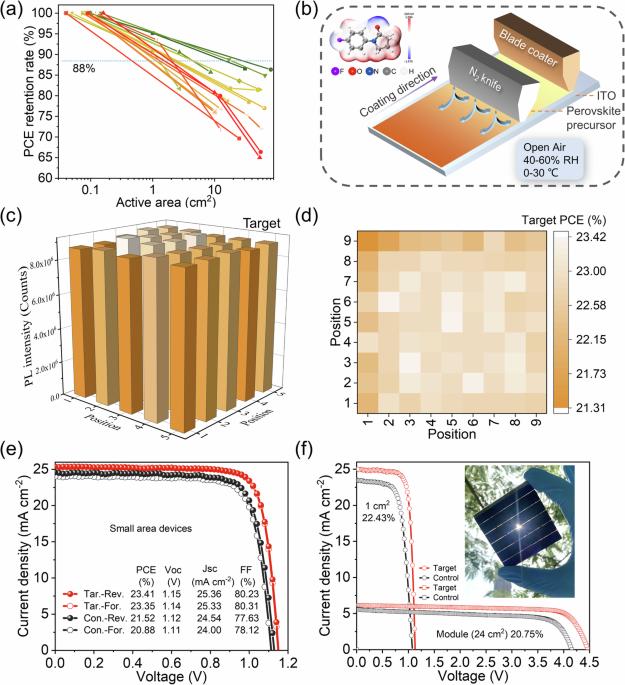自沉积钝化技术用于降低过氧化物太阳能电池的可扩展加工损耗
IF 7.5
Q1 MATERIALS SCIENCE, MULTIDISCIPLINARY
引用次数: 0
摘要
随着过氧化物薄膜和器件面积的增加,其性能趋于恶化,这可能是由于没有适当的钝化,缺陷在底面积累所致。在这里,我们引入了 1-(4-氟苯基)-2-吡咯烷酮分子(FPP)作为大面积叶片涂层过氧化物薄膜的添加剂。在自上而下的结晶过程中,FPP 分子与包晶成分形成中间相,并随后自沉积在底部表面。因此,大面积薄膜的结晶动力学得到了调节,底面在一步处理过程中得到了有效而均匀的钝化。通过采用这种自沉积钝化方法(SDP),器件面积扩大导致的效率下降得到了显著抑制,器件的功率转换效率分别为 23.41% (0.09 cm2)、22.43% (1 cm2) 和 20.75% (24 cm2)。该方法适用于商业制造,可扩大太阳能电池面积并保持高效率。叶片涂层可生产大面积的过氧化物太阳能电池,但随着薄膜面积的增加,设备性能往往会降低。这里使用了一种添加剂来控制薄膜结晶,以实现高功率转换效率,这归功于一种自沉积钝化方法本文章由计算机程序翻译,如有差异,请以英文原文为准。

Self-deposited passivation for decreasing scalable processing loss of perovskite solar cells
With the area of perovskite films and devices increases, the performance tends to deteriorate, which can be attributed to the accumulation of defects at the bottom surface without proper passivation. Here, we introduce the 1-(4-Fluorophenyl)−2-pyrrolidone molecule (FPP) as additive in large-area blade-coating perovskite films. During the top-down crystallization process, the FPP molecule form an intermediate phase with the perovskite components and subsequently self-deposit at the bottom surface. Consequently, the crystallization kinetics of the large-area thin films are regulated, and the bottom surface is effectively and uniformly passivated in one single-step processing. By employing this self-deposited passivation method (SDP), the efficiency decrease caused by the expansion of the device area has been significantly suppressed and the devices yield power conversion efficiency of 23.41% (0.09 cm2), 22.43% (1 cm2), and 20.75% (24 cm2). The method is compatible for commercial manufacturing with scaling up solar cell area and holding high efficiency. Blade-coating produces large-area perovskite solar cells, but device performance is often reduced as the area of the film increases. Here, an additive is used to control film crystallization to achieve high power conversion efficiency, attributed to a self-deposited passivation method
求助全文
通过发布文献求助,成功后即可免费获取论文全文。
去求助
来源期刊

Communications Materials
MATERIALS SCIENCE, MULTIDISCIPLINARY-
CiteScore
12.10
自引率
1.30%
发文量
85
审稿时长
17 weeks
期刊介绍:
Communications Materials, a selective open access journal within Nature Portfolio, is dedicated to publishing top-tier research, reviews, and commentary across all facets of materials science. The journal showcases significant advancements in specialized research areas, encompassing both fundamental and applied studies. Serving as an open access option for materials sciences, Communications Materials applies less stringent criteria for impact and significance compared to Nature-branded journals, including Nature Communications.
 求助内容:
求助内容: 应助结果提醒方式:
应助结果提醒方式:


